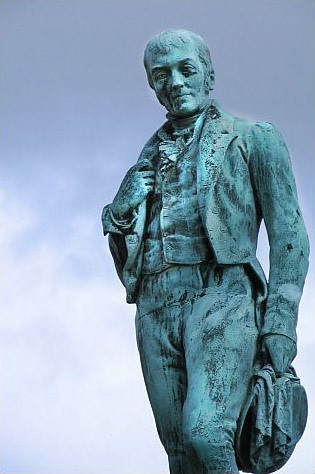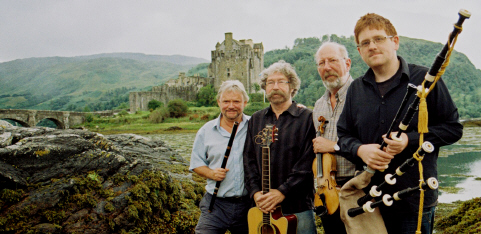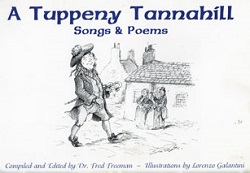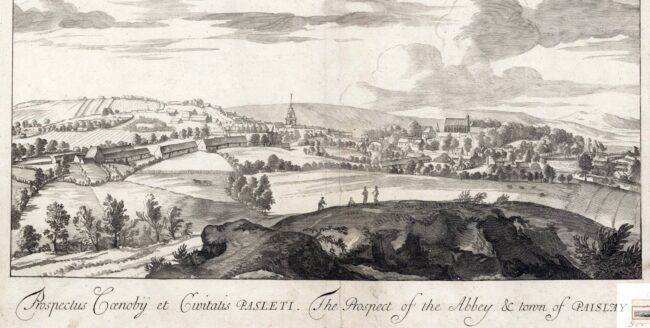♬The Complete Songs of Robert Tannahill ( Fred Freeman )
Robert Tannahill songs in The Thistle&Shamrock
Paisley ieri e oggi

Robert Tannahill (1774-1810), il poeta tessitore, è nato a Paisley (una grossa città alla “periferia” di Glasgow) nel Renfrewshire, Scozia, poeta e musicista contemporaneo di Robert Burns non divenne altrettanto famoso, anche perché distrusse gran parte della sua produzione prima di suicidarsi a 34 anni.
“..figlio d’un tessitore e tessitore egli stesso. Robert Burns fu tra i primi poeti ch’ egli lesse, ma Tannahill lo vince nella dolcezza malinconica. Le sue ingenue canzoni divennero veramente popolari: il popolo della Scozia le cantava, e le canta tuttora, sulla musica composta da R. A. Smith” (tratto da qui)
Tannahill aborriva il sistema capitalistico legato allo sfruttamento industriale, foriero di guerre imperialistiche nel nome del potere e del denaro in mano a una ristretta elitè. Nelle sue poesie esprime spesso il concetto romantico della solitudine, l’immersione nella natura per staccare la spina dalla vita urbana e nutrire lo spirito e l’immaginazione, tuttavia non era uno spirito solitario, vissuto per la maggior parte della sua breve vita a Paisley si tenne sempre in contatto con la vicina Glasgow.
“Aveva amici a Glasgow e nelle città vicine, frequentava il teatro di Glasgow e, cosa più importante, aveva familiarità con gli editori di Glasgow specializzati nella vendita delle poesie-ballate. Le sue prime opere furono anche stampate nel Corriere di Glasgow, che gli valse il riconoscimento di poeta pubblicato nei periodici. La prima raccolta di Tannahill fu “Il ritorno del soldato”: un intermezzo scozzese in due atti, con altre poesie e canzoni, principalmente in dialetto scozzese. Si vendette bene, e l’ultima parte del titolo è un chiaro omaggio a Burns.
Robert Archibald Smith (1780-1829), noto come il direttore musicale delle chiese in Scozia, compose arie per molte delle canzoni di Tannahill in seguito alla loro amicizia come compagni tessitori. La loro relazione è un esempio della vivacità delle città satellite di Glasgow quale contributori alla tradizione musicale e poetica della Scozia. “(tradotto da qui)
Nel 1805, Tannahill fondò un Burns Club nella Sun Tavern sulla High Street. Tra coloro che hanno partecipato c’erano l’autore James Hogg e il poeta locale Robert Allan.
Nella sua dimora al numero 11 di Queen Street si ritrova ancora oggi il Tannahill Club di Paisley
[English version]
Robert Tannahill (1774-1810), weaver and poet, was born in Paisley (a large town near Glasgow) in Scotland, Robert Burns‘ contemporary poet and musician, did not become as famous, partly because he destroyed much of his production before committing suicide at age 34.
“..the son of a weaver and weaver himself.” Robert Burns was among the first poets he read, but Tannahill won him in melancholy sweetness, and his naive songs became very popular: the people of Scotland sang them, and still sings, on the music composed by RA Smith “(translate from here)
Tannahill abhorred the capitalist system linked to industrial exploitation, herald of imperialist wars in the name of power and money in the hands of a restricted elite. In his poems he often expresses the romantic concept of solitude, a total immersion in nature to pull the plug from urban life and nourish the spirit and imagination. However he was not a solitary spirit, lived most of his short life in Paisley, he kept in touch with neighboring Glasgow
“He had friends in Glasgow and neighbouring towns, attended the theatre in Glasgow and, importantly, was familiar with the publishers in Glasgow who were established in selling ballad poetry. His early works were also printed in the Glasgow Courier, leading to his recognition as the leading poet of the periodicals. Tannahill’s first collection was “The soldier’s return”: a Scottish interlude in two acts, with other poems and songs, chiefly in the Scottish dialect. It sold well, and the latter part of the title is a clear homage to Burns.
Robert Archibald Smith (1780-1829), renowned as the leading church musician in Scotland, composed airs for many of Tannahill’s songs following their friendship as fellow weavers. Their relationship is an example of the vibrancy of Glasgow’s satellite towns as contributors to Scotland’s poetic and musical tradition.” (from here)
In 1805, Tannahill founded a Burns Club in the Sun Tavern on the High Street. Among those who attended were author James Hogg and local poet Robert Allan.
Paisley’s Tannahill Club is still located in his home at 11 Queen Street

Paisley’s son
“Spesso definito” figlio di Paisley “, Robert Tannahill ha lasciato un’eredità unica di canzoni e poesie, molte delle quali sono state ispirate dai fiori selvatici e dagli uccelli trovati nei paesaggi di Gleniffer Braes e nei boschi e brughiere che circondavano Paisley ai suoi tempi. Spesso questi paesaggi assumono associazioni romantiche e metaforiche con figure care al cuore del poeta. “(tradotto da qui)
Sebbene il suo primo libro di poesie “The Soldier’s Return: a Scottish interlude in two acts, with other poems and songs” sottotitolato in omaggio a Robert Burns “Chiefly in the Scottish Dialect” fosse andato esaurito alla sua prima pubblicazione nel 1807, Tannahill si vide respingere da ben due editori di Edimburgo la sua seconda raccolta. In preda alla depressione, che lo consumò nel corpo e nello spirito, bruciò i suoi scritti e si annegò gettandosi in un canale il 17 maggio 1810.
Fortunatamente molte sue poesie vennero pubblicate dall’amico R. A. Smith nella sua raccolta “The Scotish Minstrel. A Selection from the Vocal Melodies of Scotland Ancient & Modern arranged for the Piano Forte by R. A. Smith” (1821–4)
Often referred to as “Paisley’s son”, Robert Tannahill left a unique legacy of songs and poems, many of which were inspired by the wild flowers and birds found on the landscapes of the Gleniffer Braes and the woods and burns surrounding the Paisley of his day. Often these landscapes assume romantic and metaphoric associations with figures dear to the poet’s heart. ” (from here)
Although his first book of poetry “The Soldier’s Return: a Scottish interlude in two acts, with other poems and songs” subititled in homage to Ronert Burns “Chiefly in the Scottish Dialect” was sold out in its first publication in 1807, Tannahill saw himself rejecting his second collection from two publishers in Edinburgh. In the grip of depression, which consumed him in body and spirit, he burned his writings and drowned himself by throwing himself into a canal on May 17, 1810.
Fortunately many of his poems were published by his friend R. A. Smith in his collection “The Scotish Minstrel. A Selection from the Vocal Melodies of Scotland Ancient & Modern arranged for the Piano Forte by R. A. Smith” (1821–4)
RISORSE
Poems and Songs of Robert Tannahill (with life and notes by David Semple) Paisley, Alex Gardner, 1874
https://www.wikitree.com/photo.php/3/3c/Tannahill-77.pdf
The works of Robert Tannahill : with life of the author, and a memoir of Robert A. Smith, the musical composer
https://ia800200.us.archive.org/12/items/poemssongsofrobe00tannrich/poemssongsofrobe00tannrich.pdf
Nel web
https://www.electricscotland.com/history/men/tannahill_robert.htm
http://www.grianpress.com/Tannahill/THE%20ROBERT%20TANNAHILL%20PAGE.htm
https://theses.gla.ac.uk/2395/1/2011fergusonphd.pdf
http://www.rampantscotland.com/famous/blfamtannahill.htm
http://www.roberttannahillfederation.com/1.html
https://roberttannahill.weebly.com/
http://www.tannahillmacdonaldclub.co.uk/tannahill/
Omaggi a Robert Tannahill nel Folk- Revival
A richiamare il nome del bardo dimenticato furono per primi i Tannahill Weavers loro concittadini i quali, a partire dagli anni ’70, hanno divulgato molte canzoni di Tannahill, nella loro lunga e premiata carriera artistica.

The Complete Songs of Robert Tannahill
La raccolta completa delle sue canzoni prodotta da Fred Freeman consiste in ben 4 Cd pubblicati in 4 volumi.
Freeman scrive: “Tannahill, come Burns, era ossessionato dal ritmo della musica tradizionale scozzese … strathspeys e reels, jigs, slip jigs, hornpipes … Burns … era un violinista, e Tannahill, una flautista. … usava metodi di composizione ritmica … Tannahill, il tessitore, manovrava la spoletta e formulava le sue parole con il ritmo delle danze scozzesi profondamente impresse nella sua mente. “
The complete collection of his songs produced by Fred Freeman consists of 4 Cd published in 4 volumes.
Freeman writes: “Tannahill, like Burns, was obsessed with rhythm in Scottish traditional music…strathspeys and reels; jigs, slip jigs, hornpipes…Burns…was a fiddler, and Tannahill, a flautist. Both…employed rhythmical methods of composition…Tannahill, the weaver, plying the shuttle and formulating his words with the beat of the Scottish dances deeply etched in his mind.”
The Complete Songs of Robert Tannahill Volume I (2006)
1. Fly We To Some Desert Isle (Emily Smith)
2. Hey Donald, How Donald (Wendy Weatherby)
3. Rab Roryson’s Bonnet (Gillian MacDonald)
4. Braes O Balquidder (John Croall)
5. The Five Friends (Jim Reid) -Nid-nid Noddin
6. Coggie Thou Heals Me (Ross Kennedy)
7. Meg o the Glen (John Croall)
8. When John and I were Married (Gillian MacDonald)
9. Jessie, The Flow’r o Dunblane (Ross Kennedy)
10. O Are Ye Sleeping Maggie (Jim Reid)
11. Barrochan Jean (John Morran)
12. Och Hey! Johnny Lad (Emily Smith)
13. The Dear Highland Laddie O (Gillian MacDonald)
14. Yon Burn Side (Ian Anderson)
15. With Waefu’ Heart (Wendy Weatherby)
16. I’ll Hie Me To The Shieling Hill (Ross Kennedy)
17. Molly My Dear (Ross Kennedy)
18. Eild (Fred Freeman)
19. I’ll Lay Me On The Wintry Lea (Emily Smith)
The Complete Songs of Robert Tannahill Volume II (2010)
1. My Mary (Jim Malcolm)
2. Gloomy Winter’s Now Awa’ (Emily Smith)
3. One Night in my Youth (Brian O’ Headhra)
4. Brave Lewie Roy (Nick Keir)
5. The Soldier’s Adieu (Steve Byrne)
6. While the Grey Pinioned Lark (Emily Smith)
7. Fragment of a Scottish Ballad (Lucy Pringle)
8. Bonnie Winsome Mary (Brian O’ Headhra)
9. Come Hame Tae Yer Lingels (Jim Malcolm)
10. Oor Bonnie Scots Lads (Lucy Pringle)
11. Hey Donald, How Donald (original version) (Marieke McBean)
12. The Lomond (Steve Byrne)
13. Peggy O’Rafferty (Brian O’ Headhra)
14. Mine Ain Dear Somebody (Emily Smith)
15. O Lassie Will Ye Tak a Man? (Steve Byrne)
16. Kitty Tyrell (Brian O’ Headhra)
17. O Sair I Rue the Witless Wish (Steve Byrne)
18. Noo Winter Wi His Cloody Broo (Nick Keir)
19. Poem: On Seeing a Spider… (Fred Freeman)
20. The Soldier’s Widow (Lucy Pringle)
21. Bonnie Hielan Laddie (Jim Malcolm)
The Complete Songs of Robert Tannahill Volume III (2012)
1.Will Ye Gang Tae Sherramuir (Rod Paterson)
2. The Braes O Gleniffer (Fiona Hunter)
3. Ye Friendly Stars (Nick Keir)
4. Adieu! Ye Cheerful Native Plains (Brian O hEadhra)
5. Thou Cauld Glommy Feberwar (Fiona Hunter)
6. The Simmer Gloamin (Lucy Pringle)
7. Lallan Lassie Wilt Thou Go (Nick Keir)
8. Despairing Mary (Lucy Pringle)
9. Fill, Fill The Merry Bowl (Rod Paterson)
10. The Lassie Aa Leuch (Fiona Hunter)
11. The Hielander’s Invitation (Brian O hEadhra)
12. The Lament O Wallace (Lucy Pringle)
13. Irish Teaching (Brian O hEadhra)
14. Responsive Ye Woods (Ian Anderson)
15. I’ll Soon Be Far Away (Nick Keir)
16. The Dirge Of Carolan (Brian O hEadhra)
17. Davie Tulloch’s Bonnie Katie (Fiona Hunter)
18. Noo Winter is Gane (Rod Paterson)
19. The Trifler’s Sabbath Day (Fred Freeman)
20. Lament For Poor Drimindo / Kitt O’Carrol (Iain Anderson And Lucy Pringle)
21. The Lass O Arranteenie (Rod Paterson)
The Complete Songs of Robert Tannahill Volume IV (2016)
1. Thou Bonnie Wood O Craigielea (Claire Hastings)
2. Fickle Freenship An Caul Misfortune (Rod Paterson)
3. Return O Gallant Sons & Ma Days Hae Flow + Weep Not My Love (Fiona Hunter)
4. Shelah, My Darling (Brian O’hEadhra)
5. Unrequited Love & The Fareweel (Claire Hastings)
6. The Worn Sodger (Ross Kennedy)
7. Companion of My Youthful Sports (Fiona Hunter)
8. Killoch Burn & Ye Dear Romantic Shades (Wendy Weatherby)
9. The Wandering Bard (Claire Hastings)
10. Loudon’s Bonnie Woods and Braes (Rod Paterson)
11. From the Rude Bustling Camp (Ross Kennedy)
12. Laddie, Can Ye Lea Me & O How Can Ye Gang Laddie? (Fiona Hunter)
13. Awake My Harp (Brian O’hEadhra)
14. Ye Wooer Lads (Rod Paterson)
15. Ma Ain Kind Dearie, O & Fair-Hair’D Nannie, O (Wendy Weatherby)
16. The Irish Farmer (Brian O’hEadhra)
17. The Recruiting Service Drum (Fred Freeman)
18. Green Inismore (Brian O’hEadhra)
19. Faithful Ellen More (Ross Kennedy)
20. The Banks O Spey (Claire Hastings)
Si segnala inoltre l’omaggio di Sam Monaghan in The Tannahill Song Book 2000 su musica arrangiata o composta da Alastair MacDonald.
Sam Monaghan è stato corista dell’Abbazia di Paisley per diventare voce solista nel Paisley Male Voice Choir
A TUPPENY TANNAHILL SONGS & POEMS, 2009

Fred Freeman ha pubblicato questa edizione pensando alle scuole, con un adattamento melodico semplificato, un glossario approfondito e le illustrazioni di Lorenzo Galantini
Robert Tannahill songs in The Thistle&Shamrock
Ascolta la musica e conosci la breve vita di un poeta del 18 ° secolo che ha scritto nello stile di Robert Burns e ha composto canzoni amate, ancora ampiamente cantate oggi. Gli artisti presenti includono Dougie MacLean, The Tannahill Weavers e Emily Smith.
Hear the music and learn about the short life of an 18th century poet who wrote in the style of Robert Burns and composed well-loved songs that are still widely sung today. Artists featured include Dougie MacLean, The Tannahill Weavers, and Emily Smith. (npr music)
Paisley ieri e oggi
Gli edifici più significativi di Paisley sono Abbey Close del XII sec, il municipio di Paisley di epoca vittoriana, l’Art Déco Russell Institute degli anni ’20


Per avere un’idea di come vivevano e come lavoravano i tessitori pre-industriali una tappa d’obbligo è Sma’ Shot Cottages si veda anche la scheda in Terre Celtiche Blog Weaver Songs ( I canti dei tessitori)
https://paisley.is/visit/discover-paisley-on-our-walking-trail/
https://www.renfrewshire.gov.uk/media/6104/Paisley-Town-Centre-Conservation-Area-Appraisal/pdf/Conservation_area_appraisal-Draft2017-v17-220318AR.pdf?m=1521732037320
https://paisley.is/listing/soak-up-the-sights-in-paisley/
http://mansions.paisleyhistory.uk/therest.htm
